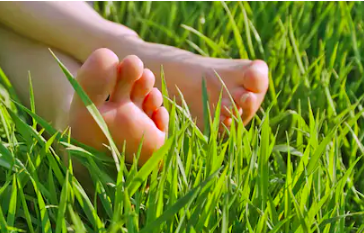
Patios beware, bare feet prefer lawns that fight climate change
Let lawns capture more carbon and better protect homes from extreme weather events.
Your lawn will fight climate change if you stop spreading conventional (quick-release) fertilizer. Established lawns, like the grasslands of long ago, are usually quite capable of not needing fertilizer. The five pounds per thousand square feet of lawn called for by the industry is excessive. You may ignore the printing on the bag that says to spread Easter, Memorial Day, Fourth of July, Labor Day, and in the fall (like they can't wait until Columbus Day to make the sale).
The fertilizer that people go out and buy or pay a professional lawn care specialist to spread, is spread so thick and frequently that the grass plants are virtually swimming in nitrogen (until it's washed away). Without it, plants roots go deeper (and no pollutants dirty water). The plants become healthier, more resilient, put on more foliage, and grow in denser. Denser grass plants are more resistant to weeds and pests. Save on not buying those chemicals, too.
Lawns free of quick-release capture more carbon, put on more foliage, become better sponges retaining and releasing slowly excess water from extreme weather events. Consider pulling up impervious surfaces and replacing with a healthy lawn.
Patios beware. Bare feet prefer lawns and lawns fight climate change.
|
|

Stop over-fertilizing your lawn to stop harmful algal blooms
Nitrogen pollution from lawn fertilizer runoff wreaks havoc on our local waters, ecosystems, and climate. Conventional fertilizer (also known as quick-release) runs off into our watersheds when it rains, resulting in harmful algal blooms. These algal blooms are not only deadly to fish and hazardous for people, they accelerate climate change. When the algae in these blooms die, they create areas of depleted oxygen,"ocean dead zones," unable to support any life.
Not only do algal blooms desecrate our waterways, they also contribute to climate change. From this rotting mess, methane is released into the atmosphere. Global methane emissions are expected to grow 30-90% over the century due to increasing nutrient pollution and algal blooms. Over time, methane emissions from algal blooms are expected to equal a third of our annual CO2 emissions from fossil fuels. Seriously!
By stopping the use of quick-release fertilizer, you can help stop algal blooms with less methane release.
Commit to a cleaner waterways by getting the yuck out.
|
The proof is in the green clean lawns of Falmouth
Falmouth passed a bylaw prohibiting the use of quick-release fertilizer on lawns after 16 striped bass and a horseshoe crab were found dead, having swum in to an ocean dead zone in Little Pond in July 2012. Since Falmouth acted there has not been another fish kill. And, no surprise, Falmouth lawns are just as green as the lawns in neighboring towns that spread three to five pounds of quick-release. Save money while saving fish. What's not to like about Falmouth's Bylaw?.*
*The fertilizer industry was so outraged by the Falmouth Bylaw that they convinced the state office of the attorney general to prohibit towns from directing lawn care or establishing how close to waterways one could fertilize. The Falmouth Bylaw is the one exception that survives because the local state senator was Therese Murray and the Senate President put the lawn care bylaw into the state's budget bill.
|
Slow-release fertilizer, in modest amounts spring or fall, feeds grass over time while roots go deep.
Slow-release fertilizer consists of bits of nitrogen surrounded by a smooth polymer that dissolves slowly over time when there is moisture. During dry spells or winter when the grass is dormant the nitrogen remains bound up. It is there when the grass needs it.
Conventional fertilizers for lawns are much like feeding children a high sugar breakfast, they'll consume it quickly and be hungry before lunch. Slow-release fertilizer is like a high protein breakfast that will last for much longer. For grass in New England it could be months, unless it's a wet summer. Then the grass may grow more and capture more carbon.
Use only 100% slow-release fertilizer such as the one pictured above because all of it will benefit the grass over time and zero percent can wash away from the grass. The polymer that is encasing the nitrogen bits is fortified with eleven essential nutrients primarily for soil microbes.
For healthier soils, especially for lawns inundated by quick-release fertilizer, consider applying a half pound per thousand square feet of lawn of slow-release fertilizer.
|
 |
|
Choose from more than 100 radio broadcast episodes, also free on iTunes
Join ORI's Fan page on Facebook.
We've surpassed 6,000 likes. When you and friends like us, it helps us get the word out and makes it easier for others to donate.
Wear with pride ORI logo items.
|
|
|
|
|